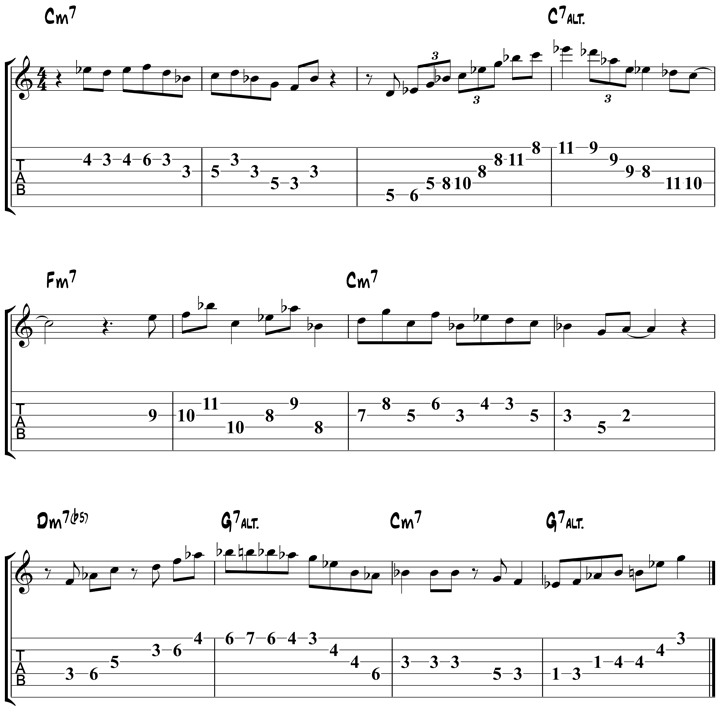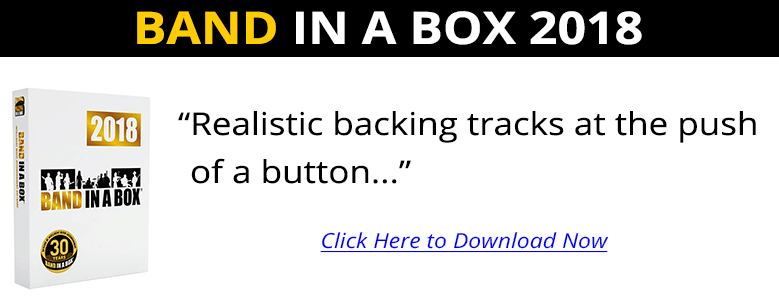When learning how to solo in jazz, one of the scales that comes up in our studies time and again is the altered scale, which is the 7th mode of the Melodic Minor Scale. While this scale comes up often when reading about jazz improvisation, it can seem like a bit of a mystery.
To help demystify the altered scale in your playing, this lesson will explain how to build and apply the altered scale, as well as explore common scale fingerings and melodic phrases.
What You Will Learn in This Guitar Scale Lesson
What Is The Altered Scale?
The first item on our checklist of altered scale studies is digging into the construction of this commonly used melodic device.
The altered scale is the 7th mode of the melodic minor scale, which means that it is like playing Ab melodic minor starting from the note G. The altered scale is used to solo over dominant 7th chords, both in major and minor keys.
The altered scale contains all four of the common altered notes (b9-#9-b5-b13), which are used to create tension over the underlying chord when applying this scale to a soloing situation.
Here is a reference chart that lays out the notes and intervals for the G altered scale in comparison to the G Mixolydian scale.
Because there are two 9th intervals in the altered scale (b9 and #9), the chart below uses the upper extensions to indicate the notes above the octave, 9-11-13, and their alterations. To make things easier to read and compare, the Cb note from G altered is written as B in this case.
| G mixolydian scale | G | A | B | C | D | E | F |
|---|---|---|---|---|---|---|---|
| 1 | 9 | 3 | 11 | 5 | 13 | b7 | |
| G altered scale | G | Ab | Bb | B | Db | Eb | F |
| 1 | b9 | #9 | 3 | b5 | b13 | b7 |
Altered Scale vs Diminished Scale
The altered scale has a lot of similarities with the half-whole diminished scale:
| G Diminished Scale | 1 | b9 | #9 | 3 | b5 | 5 | 13 | b7 |
|---|---|---|---|---|---|---|---|---|
| G Altered Scale | 1 | b9 | #9 | 3 | b5 | b13 | b7 | |
As you can see in the table above, both scales have a lot of similar notes. The difference between the two is:
- The diminished scale has eight notes (octatonic), while the altered scale has 7 notes.
- The diminished scale has a 5 and 13, while the altered scale has a b13.
These two scales are also used for different purposes:
- The altered scale is used to improvise over altered dominant chords (G7#9b13 for example).
- The half-whole diminished scale is used to play over G13b9 chords.
Altered Scale Fingerings
After studying the theory behind the altered scale, you are now ready to learn a few fingerings in various positions of the fingerboard.
To begin, here is an in-position G altered scale:
Listen & Play Along:

You can also learn a shifting position for this scale as you take a sliding up the neck approach to playing the G altered scale:
Listen & Play Along:

You can also practice the altered scale starting from the 5th string root note, which you can see here as an in-position fingering from a G root note:
Listen & Play Along:

Here is a 5th-string root G altered scale that uses a shift at the second octave in order to slide up to the second half of the scale:
Listen & Play Along:

Altered Scale Licks
With some or all of these altered scale fingerings under your belt, you’re ready to move on to studying common altered scale vocabulary, beginning with short phrases that are played only over the 7alt chord itself.
Start by learning these short phrases, and integrating them into your soloing lines over backing tracks, before moving on to the longer ii-V-I phrases in the next section of the lesson.
Altered Scale Lick 1
To begin, here is a classic lick that is found in the playing of Wes Montgomery, Pat Martino, and other legendary players.
Notice the use of the AbmMaj7 arpeggio (G-Eb-B-Ab) in the second half of the phrase:
| Abm/maj7 Arpeggio | Ab | Cb | Eb | G |
|---|---|---|---|---|
| Played over G7 | b9 | 3 | b13 | 1 |
Listen & Play Along:

Altered Scale Lick 2
Here is a commonly used altered scale technique, where you use the major triads from the b5 and b13 of the underlying scale (in this case Db and Eb over G7alt), to outline that 7alt chord in your lines:
| Db Triad | Db | F | Ab |
|---|---|---|---|
| Played over G7 | b5 | b7 | b9 |
| Eb Triad | Eb | G | Bb |
|---|---|---|---|
| Played over G7 | b13 | 1 | #9 |
Listen & Play Along:

Altered Scale Lick 3
The final short altered phrase you’ll learn is called the “Cry Me a River Lick”, as it comes from a melody fragment found in this classic jazz standard.
Listen & Play Along:

When you have these three sample phrases under your fingers, try experimenting with the altered scale and coming up with three or more patterns of your own that you can use in your jazz guitar soloing lines and phrases.
Altered Scale ii-V-I Licks
Here are three ii-V-I licks that use the altered scale over the V7 chord in each progression.
Try putting on a backing track, such as a minor blues or a tune like Solar, and practice adding these licks into your soloing lines in a musical situation.
ii V I Altered Scale Lick 1
To begin, here is a short ii-V-I lick in the key of C minor that uses the G altered scale to outline the V7 chord in the second half of bar one in the phrase.
Listen & Play Along:

ii V I Altered Scale Lick 2
We’ll now move on to using the G altered scale to outline the V7 chord in a longer ii-V-I phrase in the key of C major.
Listen & Play Along:

ii V I Altered Scale Lick 3
This last lick uses the G altered scale over the V7 chord in a longer ii-V-I phase in the key of C major.
The altered scale is a great device for creating tension over the V7 chord in a major key, but just be careful that you resolve that tension either over the same V7 chord, or in the Imaj7 chord that follows so you don’t leave those tense notes hanging in your lines.
Listen & Play Along:

Altered Scale Solo Over C Minor Blues
Now that you know how to play the altered scale in four positions on the fretboard, as well as have studied classic altered vocabulary, you can take those ideas to a sample solo.
Here is a 12-bar solo written out over a C minor blues progression, with the altered scale being used to outline the chords in bars 4, 10, and 12.
Once you have learned this solo as written, try putting on a backing track and play this solo once, followed by an improvised solo in the second chorus, alternating back and forth as you begin to integrate these ideas into your improvisational repertoire.
Listen & Play Along:

Do you have questions about the altered scale? Let us know in the comments below…
More Guitar Scale Lessons



In Ab scale fifth Degree is Eb and Eb7
Iwant make scale Ebmaj in fifth degree
Wich is mood?
I often play the Alt scale a fifth up from the m7 chord. E.g. with an Am 7 chord I play E Alt. It sounds very good and seems to have most of the notes of the chord. (I found this out by accident.)
Cool idea with the Eb minor triad and Db major triad over G7. I don’t play Jazz so how would you approach developing more modern ideas? Licks are great for some and interesting to learn from but its not my path. interested in developing my own voice.
Do you mean C7alt = x323x4 and not x3234x???
No, it’s x3234x, C7#9 for C7alt
Hello
I follow your lesson for a few months and I find them of great quality and I can not thank you enough for all the time you spend sharing your knowledge …
Since that time, I have discovered that the triads help me a lot to improve my phrasing, concerning this subject could you give us even if you have a little touched in your article, triads or blocks of notes that could serve me to imagine less academic paterns.
thank you in advance
Bonjour de France
and thanks in advance
sure, use major triads from the b5 and b6 of any 7th chord to create an altered sound
How to voice the C7 and G7 altered chords in the last exercise?
Try these
C7alt = x3234x
G7alt = 3x344x
do you mean C7alt = x323x4 and not x3234x???
Thank you, I now realise I have been using this scale – but only ever three or four notes of it at a time. Wow, it sounds horrible when you play the whole scale over and over again! Maybe emphasise how sparing you could be with it? It’s nonetheless very effective when played that way.
My guitar teacher compared this scale with the melodic minor scale a half tone above the root. So you don’t have to learn or practice a new fingering if you know the melodic minor scale. The postitions on the fretboard are the same
This was helpful. Is there a print version of it?
Hi Max, there’s a “Print & PDF” button at the bottom of the lesson.
Jazz phrasing is the ultimate goal of most players. Once you think you are finally a player WRONG as it takes years to become a jazz player. Most anyone can noodle with pentatonic scales but when you listen to a jazz guitarist it is another world.
This site is the best…
Do not comprehend yet will study altered scale.
great lesson!! thanks!!